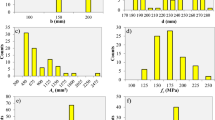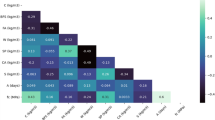Abstract
Concrete is the predominant material in the construction industry, offering a wide range of mechanical attributes, including impressive compressive strength, excellent durability, robust plasticity, and a high elasticity modulus. Concrete properties prediction is crucial in designing components and also to improve their performance. High-complexity network-based baseline deep learning methods for predicting concrete may cause high computational time and high cost with the high-complexity network. To report this problem the proposed study aims to achieve better prediction of mechanical properties in the concrete using lightweight Bidirectional Long Short Term Memory (Bi-LSTM) which involves a weight pruning method and the parameters are tuned using Gridsearch Cross Validation (CV). The input variable is the grey image of the concrete microstructure, and the Representative Volume Element (RVE) provides the ground truth value to deep learning for the most efficient prediction of mechanical properties. Then the lightweight Bi-LSTM is trained, tested, and validated using 10-fold cross-validation after the parameter tuning. The Mean Absolute Error (MAE), Mean Absolute Percentage Error (MAPE), Root Mean Square Error (RMSE), and Coefficient of Determination (R2), which show the variability in the experimental score and the projected score, are used to quantify the mistakes of the suggested model’s prediction capability. According to experimental outcomes, the suggested lightweight Bi-LSTM approach outperforms the LSTM and Bi-LSTM approaches on the training and test datasets. Furthermore, compared to other models, the lightweight Bi-LSTM model runs much faster, making it more efficient for predictions.





Similar content being viewed by others
Data availability
Data will be shared on the reasonable request.
References
Ziółkowski P, Niedostatkiewicz M (2019) Machine learning techniques in concrete mix design. Materials 12:1256. https://doi.org/10.3390/ma12081256
Feng DC, Liu ZT, Wang XD, Chen Y, Chang JQ, Wei DF, Jiang ZM (2020) Machine learning-based compressive strength prediction for concrete: An adaptive boosting approach. Constr Build Mater 10(230):117000
Chopra P, Sharma RK, Kumar M (2015) Artificial neural networks for the prediction of compressive strength of concrete. Int J Appl Sci Eng 13(3):187–204
Chaabene WB, Flah M, Nehdi M (2020) Machine learning prediction of mechanical properties of concrete: Critical review. Constr Build Mater 260:1–18. https://doi.org/10.1016/j.conbuildmat.2020.119889
Han Z, Zhao J, Leung H, Ma KF, Wang W (2019) A review of deep learning models for time series prediction. IEEE Sens J 21(6):7833–7848
Basyigit C, Çomak B, Kılınçarslan Ş, Üncü I (2012) Assessment of concrete compressive strength by image processing technique. Constr Build Mater 37:526–532. https://doi.org/10.1016/j.conbuildmat.2012.07.055
Shaswat K (2019) Hybrid-based deep belief network model for cement compressive strength prediction. Comput J 64(1):909–920. https://doi.org/10.1093/comjnl/bxaa197
Gupta T, Sachdeva SN (2021) Recurrent neural network-based prediction of compressive and flexural strength of steel slag mixed concrete. Neural Comput Applic 33:6951–6963. https://doi.org/10.1007/s00521-020-05470-w
Duan ZH, Kou SC, Poon CS (2013) Using artificial neural networks for predicting the elastic modulus of recycled aggregate concrete. Constr Build Mater 44:524–532, ISSN 0950–0618. https://doi.org/10.1016/j.conbuildmat.2013.02.064
Singh P, Adebanjo A, Shafiq N et al (2023) Development of performance-based models for green concrete using multiple linear regression and artificial neural network. Int J Interact Des Manuf. https://doi.org/10.1007/s12008-023-01386-6
Joshi DA et al (2023) Deep learning based concrete compressive Strength prediction model with hybrid meta-heuristic approach. Expert Syst Applic 233:120925. https://doi.org/10.1016/j.eswa.2023.120925
Muliauwan H, Prayogo D, Harsono K (2020) Prediction of concrete compressive strength using artificial intelligence methods. J Phys: Conf Ser 1625:012018. https://doi.org/10.1088/1742-6596/1625/1/012018
Gholami K, Ege F, Barzegar R (2023) Prediction of composite mechanical properties: integration of deep neural network methods and finite element analysis. J Compos Sci 7:54. https://doi.org/10.3390/jcs7020054
BKA MAR, Ngamkhanong C, Wu Y, Kaewunruen S (2021) Recycled aggregates concrete compressive strength prediction using artificial neural networks (ANNs). Infrastructures 6(2):17
Koya BP, Aneja S, Gupta R, Valeo C (2021) Comparative analysis of different machine learning algorithms to predict mechanical properties of concrete. Mech Adv Mater Struct. https://doi.org/10.1080/15376494.2021.1917021
El Said B (2023) Predicting the non-linear response of composite materials using deep recurrent convolutional neural networks. Int J Solids Struct 276:112334
Frankel AL, Jones RE, Alleman C, Templeton JA (2019) Predicting the mechanical response of oligocrystals with deep learning. Comput Mater Sci 169:109099
Haghighi EM, Na S (2022) A single long short-term memory network for enhancing the prediction of path-dependent plasticity with material heterogeneity and anisotropy. arXiv preprint arXiv:2204.01466
Chen H, Li X, Wu Y, Zuo L, Lu M, Zhou Y (2022) Compressive strength prediction of high-strength concrete using long short-term memory and machine learning algorithms. Buildings 12(3):302
Li F, He A, Song Y et al (2023) Deep learning for predictive mechanical properties of hot-rolled strip in complex manufacturing systems. Int J Miner Metall Mater 30:1093–1103. https://doi.org/10.1007/s12613-022-2536-y
Yan H, Ouyang H (2018) Financial time series prediction based on deep learning. Wireless Pers Commun 102:683–700
Drugan WJ, Willis JR (1996) A micromechanics-based nonlocal constitutive equation and estimates of representative volume element size for elastic composites. J Mech Phys Solids 44(4):497–524
Ye S, Li B, Li Q, Zhao H-P, Feng X-Q (2019) Deep neural network method for predicting the mechanical properties of composites. Appl Phys Lett 115(16):161901. https://doi.org/10.1063/1.5124529
Ye F, Wang H (2017) A simple Python code for computing effective properties of 2D and 3D representative volume element under periodic boundary conditions. arXiv preprint arXiv:1703.03930
Yang L, Zhao Q (2020) A novel PPA method for fluid pipeline leak detection based on OPELM and bidirectional LSTM. IEEE Access 8:107185–107199
Putri AR, Anyanwu GO, Maharani MP, Lee JM, Kim DS (2021) Compressed Neural Network for Thermal Array-Based Fall Detection System on Embedded AI. In 2021 International Conference on Information and Communication Technology Convergence (ICTC) (pp. 1754–1757). IEEE
Amar M, Benzerzour M, Zentar R, Abriak NE (2022) Prediction of the compressive strength of waste-based concretes using artificial neural network. Materials 15(20):7045
Keshtegar B, Bagheri M, Mundher Z (2019) Shear strength of steel fi ber-uncon fi ned reinforced concrete beam simulation: application of novel intelligent model. 212:230–242.https://doi.org/10.1016/j.compstruct.2019.01.004
Sarveghadi M, Gandomi AH, Bolandi H, Alavi AH (2015) Development of prediction models for shear strength of SFRCB using a machine learning approach. Neural Comput Appl 31:2085–2094. https://doi.org/10.1007/s00521-015-1997-6
Al-Musawi AA, Alwanas AAH, Salih SQ, Ali ZH, Tran MT, Yaseen ZM (2018) Shear strength of SFRCB without stirrups simulation: implementation of hybrid artificial intelligence model. Eng Comput. https://doi.org/10.1007/s00366-018-0681-8
Vu D, Hoang N (2016) Punching shear capacity estimation of FRP-reinforced concrete slabs using a hybrid machine learning approach. Struct Infrastruct Eng 12:1153–1161. https://doi.org/10.1080/15732479.2015.1086386
Xu J, Zhao X, Yu Y, Xie T, Yang G, Xue J (2019) Parametric sensitivity analysis and modelling of mechanical properties of normal- and high-strength recycled aggregate concrete using grey theory, multiple nonlinear regression and artificial neural networks. Constr Build Mater 211:479–491. https://doi.org/10.1016/j.conbuildmat.2019.03.234
Abu Yaman M, Elaty MA, Taman M (2017) Predicting the ingredients of self compacting concrete using artificial neural network. Alex Eng J 56:523–532
Acknowledgements
I confirm that all authors listed on the title page have contributed significantly to the work, have read the manuscript, attest to the validity and legitimacy of the data and its interpretation, and agree to its submission.
Funding
Funding information is not applicable because no funding was received.
Author information
Authors and Affiliations
Corresponding author
Ethics declarations
Competing interests
The authors declare that they have no conflict of interest. I confirm that I have read, understand and agreed to the submission guidelines, policies and submission declaration of the journal. I confirm that the paper now submitted is not copied or plagiarized version of some other published work. I understand that submission of false or incorrect information/undertaking would invite appropriate penal actions as per norms/rules of the journal.
Additional information
Publisher's Note
Springer Nature remains neutral with regard to jurisdictional claims in published maps and institutional affiliations.
Rights and permissions
Springer Nature or its licensor (e.g. a society or other partner) holds exclusive rights to this article under a publishing agreement with the author(s) or other rightsholder(s); author self-archiving of the accepted manuscript version of this article is solely governed by the terms of such publishing agreement and applicable law.
About this article
Cite this article
Prem Anand, M., Anand, M., Adams Joe, M. et al. Lightweight Bi-LSTM method for the prediction of mechanical properties of concrete. Multimed Tools Appl 83, 54863–54884 (2024). https://doi.org/10.1007/s11042-023-17796-3
Received:
Revised:
Accepted:
Published:
Issue Date:
DOI: https://doi.org/10.1007/s11042-023-17796-3







